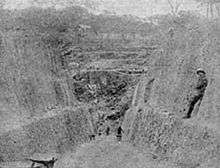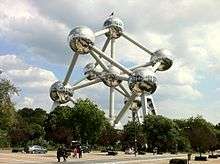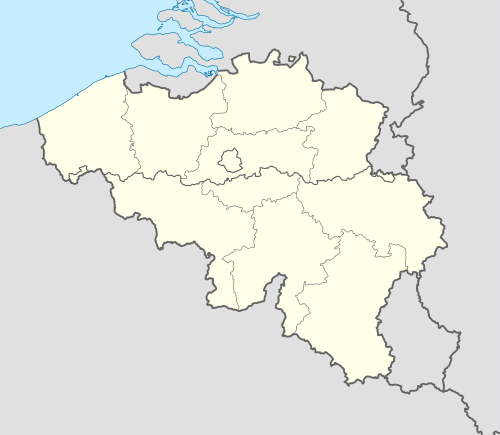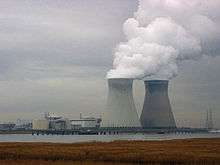Nuclear energy in Belgium
Belgium has two nuclear power plants operating with a net capacity of 5,761 MWe. Electricity consumption in Belgium has increased slowly since 1990 and in 2016 nuclear power provided 51.3%, 41 TWh per year, of the country's electricity.[1][2]
The country's first commercial nuclear power plant began operating in 1974. Belgium decided to phase out nuclear power generation completely by 2025. Although intermediate deadlines have been missed or pushed back, on 30 March 2018 the Council of Ministers confirmed the 2025 phase-out date.[3]
History
Belgium has a long industrial history in the nuclear sector. Biraco in Olen, which regularly hosted Marie and Pierre Curie, was at the start of the industrial production of radium in 1922.[4]

The uranium ore used was discovered in 1913 in Katanga in then Belgian Congo by Union Minière du Haut-Katanga. The ore found in the Shinkolobwe mine was exceptionally rich. Even before World War II the United States expressed interest, however it wasn't until 1942 when the United States required uranium for the Manhattan Project, and Belgium was one of the few countries with an appreciable stock of uranium ore, that Edgar Sengier struck a deal. For the following decade Belgium, through its colony, was one of the main suppliers of uranium to the United States. This trade relationship resulted in Belgium being granted access to nuclear technology for civil purposes.[4]
In 1952 this led to establishing SCK•CEN, a study center for nuclear research in Mol. The first reactor BR1 (Belgian Reactor 1) became critical in 1956. Construction of BR2 started the following year. The BR2 reactor is one of the five main reactors producing molybdenum-99 that decays to technetium-99m, the radioisotope used in more than 80% of diagnostic imaging procedures in nuclear medicine.[5]
In 1954 Belgium was one of the founding members of Cern, and three years later it was one of the original signatories of the Euratom Treaty.
In 1957 a site in Dessel, near SCK•CEN, was chosen as the location for Eurochemic. Thirteen OECD countries (Germany, France, Belgium, Italy, Sweden, The Netherlands, Switzerland, Denmark, Austria, Norway, Turkey, Portugal, Spain) joined forces to build a pilot nuclear reprocessing installation. The atoomwijk, a housing project for workers on private land near the site, was a scientific village unique in Europe at the time.[6]

In 1958 the Brussels World's Fair Expo 58 was to be powered by BR3. The reactor was to be built in Brussels, and open to visitors. Ultimately safety concerns and administrative problems moved the reactor to the SCK•CEN site. The other iconic symbol of the interest in nuclear technology at the time, the Atomium, housed a photo exhibition.[7]
In 1959, the Trico Center was established in Kinshasa. Its TRICO I research reactor was the first nuclear reactor on the African continent.
The US-built BR3 was connected to the grid in 1962, making it the first pressurized water reactor in Western Europe.
SCK•CEN played a key role in developing MOX fuel. In 1960, near the same site, NV Belgonuclaire, a joint venture between SCK•CEN, Electrabel and Tractebel received its first plutonium from the United States, with the goal of industrially producing MOX fuel. In 1963 BR3 was loaded with MOX fuel and was the first reactor in the world to generate electricity this way.[8]
In 1967 the commercial Chooz-A plant in France, close to the Belgian border, was connected to the grid. It had been constructed by a French-Belgian joint venture Sena (Société d'énergie nucléaire Franco-belge des Ardennes) to house a French-Belgian prototype pressurized water reactor, the first one built in Western Europe.[9] It was jointly operated and delivered electricity to both countries.[10]
In 1972 Belgium participated with The Netherlands and Germany in the failed SNR-300 fast breeder reactor. In 1973 Belgium and four other European countries formed Eurodif.
The first commercial nuclear power plant in Belgium, Doel 1, came into service in 1974. Six more rectors were connected to the grid during the following ten years. Plans for an eighth reactor were scrapped, instead utilities Electrabel and SPE took a 25% participation in the French Chooz-B nuclear power plant.
In 1974 Eurochemics ceased reprocessing. In 1987 BR3 was the first pressurized water reactor to be shut down in Europe. Decommissioning BR3 and Eurochemic has given Belgium significant expertise in the decommissioning of nuclear sites.
Currently Belgium is preparing to contribute to Generation IV reactor research through the MYRRHA project.[11]
Nuclear power plants
There are two commercial nuclear power plants operational with seven reactors:
- Doel Nuclear Power Station on the Scheldt river, near the port of Antwerp, and
- Tihange Nuclear Power Station on the Meuse river.
Both stations are operated by Electrabel.
Dessel is home to two sites for the production of nuclear fuel. One operated by FBFC, the other is being decommissioned and belonged to the Belgonucleaire company .
There are several test reactors at the SCK•CEN site in Mol. The Thetis research reactor of Ghent University is being decommissioned, and has had its fuel removed from site. None of these research reactors supply electricity to the grid.
The French nuclear power plant in Chooz is 3 kilometres (1.9 mi) from the Belgian border and surrounded on three sides by Belgian territory. The area around the power plant is subject to the same precautions as if there was a Belgian nuclear installation in the center.
Waste
Past
Belgium is one of the thirteen countries who have dumped radioactive waste in the ocean. This practise was permanently halted in 1982.
Prior to parliament placing a moratorium on nuclear reprocessing in 1993,[12] 670 tonnes of spent fuel from the commercial reactors was processed in La Hague, France. The last return transport of highly radioactive waste, mainly fission products, took place in 2007. Other types of waste will be returning from La Hague to Belgium until 2019. Spent fuel from the BR2 reactor at SCK•CEN was reprocessed in Dounreay, Scotland.[13]
Current situation
A national agency is responsible for radioactive waste management(ONDRAF/NIRAS), including transport, treatment, conditioning, storage, and disposal. The main disposal facility is the Belgoprocess (subsidiary of ONDRAF/NIRAS) site close to the towns of Mol and Dessel, which stores short-lived intermediate-level waste and high-level waste. Several shipments of reprocessed Belgian spent fuel, from France and Scotland,[14] have also arrived at the Mol-Dessel site.[1] This site offers interim storage on the surface.
Synatom, the Electrabel subsidiary that manages the fuel cycle for the commercial power plants, stores spent nuclear fuel on site before it is transferred over to ONDRAF/NIRAS. The commercial reactors produce 120 tonnes of highly radioactive spent fuel annually. In Doel it is stored dry in containers, in Tihange a spent fuel pool is used.
Long-term plans
For low and intermediate-level waste with a short half-life (less than 30 years) the cAt project was chosen in 2006. This entails encasing the waste in modular concrete boxes which will be stacked inside structures resembling tumuli in Dessel. The site is to be actively monitored for 300 years, after which the radioactivity of the waste will have decreased by a factor 1,000. A test version was built in 2011, and the project is awaiting final licensing.[15][16]
ONDRAF/NIRAS and SCK•CEN run the HADES underground laboratory through EIG EURIDICE (European Underground Research Infrastructure for Disposal of nuclear waste In Clay Environment). Since 1980 this laboratory is researching if layers of clay as found in the North-East of Belgium could be used for permanent storage of nuclear waste. [17]
In September 2011 ONDRAF/NIRAS fulfilled its legal obligation of publishing a Waste Plan.[18] The 255 page document evaluates all proposed methods of disposal and concludes by recommending storage in the aforementioned layers of clay. The final decision is a political one. No permanent storing is expected to take place prior to 2040.
In August 2018, newspaper Le Soir revealed ONDRAF/NIRAS estimates that the option of long-term deep-burying high-level radioactive waste would not cost €3.2 billion, but rather €8 to €10 billion. This is because it is now considered more adequate to bury the waste at a depth of 400 metres instead of the previously determined 200 metres. Legally, the nuclear plants' private owners, mainly Electrabel, are set to pay for this through the Synatom-managed phase-out fund.[19]
Effluent
Nuclear power stations also produce liquid and gaseous effluent. Nuclear effluent contains less radioactivity over a larger volume and is dispersed into the environment.
The Federal Agency for Nuclear Control (FANC) estimates the maximum impact of the Doel site at 0.02 mSv per year, and the maximum impact of the Tihange site at 0.05 mSv per year. The legal limit of exposure of the public to radiation from artificial sources is 1 mSv per year.[20] By comparison, the exposure to radiation during one transatlantic flight is 0.08 mSv and a CT scan of the chest is about 6.6 mSv[21] (per scan and not per year, as those are cumulative).
The liquid effluent from the Doel and Tihange sites are discharged into the Scheldt and Meuse rivers. There is no river near the Mol-Dessel sites. Its effluent is discharged via a 10 kilometres (6.2 mi) pipeline into the small river Molse Nete.[22] Which suffers from historical pollution.[23]
Phase-out
In 1999 the policy statement of the Verhofstadt I Government (a coalition including the green parties Groen! and Ecolo) introduced a plan to phase-out nuclear power generation.[24] The following year a government appointed commission reported that nuclear power was important to Belgium and recommended further development. Nevertheless, in 2003 near the end of its term Belgium's government passed phase-out legislation.[25] It stipulates that no new commercial reactors are to be built and that Belgium's seven reactors would be shut down when they reach an operational lifetime of 40 years. All reactors reach this age in the period 2015–2025.[26][27] When the law was being passed, there was speculation it would be overturned again as soon as an administration without the green parties was in power.[28] A report published in 2005 by the Federal Planning Bureau noted that in many parts of Belgium nuclear power makes up more than 50% of the electricity generated.[29] It would therefore be difficult for Belgium to adhere to the emissions targets of the Kyoto Protocols without nuclear power.[30] In 2007, the Belgian Commission on Energy said that the use of nuclear energy is imperative to meet CO
2 requirements and maintain economic stability. Furthermore, the commission believed that energy prices would double without the use of nuclear energy. The commission finally recommended that the operating lives of the seven nuclear power plants should be extended.[1] The International Energy Agency stated in 2011 that the Belgian government should reconsider the nuclear phase-out policy.[31][32]
In 2009, based on the GEMIX report, the government decided to extend the lifetimes of the three oldest nuclear power plants until 2025. In exchange, the owners would be charged an extra €215–245 million (about US$340 million) per year.[33] This was not yet finalized into law when in 2010 the government resigned over unrelated issues.[34] It was considered to be a formality, that would be taken care of when a new government was formed. However a prolonged period of political instability, without a government being formed, followed. The decision was pushed back further after the Fukushima nuclear disaster happened in March 2011. The caretaker government then decided to postpone any debate or decision in the matter until after the results of a European stress-test of the facilities were known.[35]
A couple of months prior to these results being published however the new government decided in July 2012 that only Tihange 1's lifetime would be extended to 2025. The two oldest units at the Doel site (Doel 1 and Doel 2) were set to be closed in 2015.[36] Their lifetime was however extended until 2025.[37] The remaining Belgian nuclear power plants Doel 3 is set to be closed down in 2022, Tihange 2 in 2023 and Doel 4 and Tihange 3 in 2025.
Although intermediate deadlines have been missed or pushed back, on 30 March 2018 the Council of Ministers confirmed the 2025 phase-out date and stated draft legislation would be brought forward later in the year.[3]
The cost of the phase-out, excluding waste management, is estimated in 2018 at €15.1 billion. As of 2018, Synatom has more than €10 billion in the phase-out fund, which includes the liabilities for waste management. Synatom may legally lend back three quarters of the fund's contents to its mother company Electrabel.[19]
Hydrogen damage in Doel 3 and Tihange 2
Mid August 2012 it was revealed that planned inspections, carried out in June, using a new type of ultrasound technique had detected thousands of quasi-laminar flaws in the forged rings of Doel 3's reactor vessel.[38] The Doel 3 and Tihange 2 reactors vessels were both built in the early 1980s by RDM. Subsequently Tihange 2 was also inspected with this new technique at the next planned inspection. Tihange 2 reactor vessel was found to be affected in a similar fashion.[39] During further inspections and reports from expert panels the reactors remained non-operational.[40]
Shortly after FANC had communicated the news, the government responded angrily. Suggesting they might politicize the agency and stating the director general should have kept quiet until all reports were in.[41] Three months later he was replaced by Jan Bens, a former director of the commercial nuclear powerplant Doel.[42] Jan Bens' neutrality was questioned by FANC's own experts Pierre Kockerols and Yvan Pouleur. The latter, director of internal affairs, also filed a complaint at the council of state.[43]
December 5 Electrabel, operator of the reactors in question, presented results of its investigation. It stated that the reactors could be restarted safely. The report was studied by AIB Vinçotte, BEL V, a panel of international experts and by a group of Belgian Professors. In May Kristof Calvo published the confidential reports of BEL V, and AIB Vinçotte. Both reports, compiled at the end of January, speak of uncertainties. Concerns are also raised due to the break exclusion requirement, and the fact that this level of fractures was unseen.[44][45] At the request of the European Greens, materials expert and nuclear consultant Ilse Tweer, had also published her own report in which she argued against restarting the reactors.[46]
Jan Bens stated to the Belgian Chamber of Representatives in March that the flaws were hydrogen flakes. He went on to claim that they had been there since construction and did not deteriorate.[47]
FANC postponed its decision several times, requesting more tests and information.[48][49] May 17 FANC announced that it will allow the reactors to be restarted.[50] Doel 3 was restarted June 3, 2013 after nearly a year of inactivity. Thiange 2 followed a couple days later.[51]
However, in March 2014 both reactors were taken out of service again, after the long-term tests agreed in June 2013 did not result in "the desired outcome".[52] At the end of 2015 it was announced that they would reopen.[53]
Anti-nuclear movement
On the 2012 anniversary of the Fukushima nuclear disaster, Belgian group Nucléaire Stop Kernenergie organized an event in Brussels calling for an end to the use of nuclear power and the shutting down of Belgium’s nuclear facilities. Protesters insisted that nuclear power is unsafe.[54] Austrian Chancellor Werner Faymann expects anti-nuclear petition drives to start in at least six European Union countries in 2012 with the goal of having the EU abandon nuclear power. Under the EU's Lisbon Treaty, petitions that attract at least one million signatures can seek legislative proposals from the European Commission.[55]
In 2011 an industry-commissioned poll found that while a majority of Belgians supported the decision to phase out nuclear power. In 2012 70% feared higher energy costs and 82% believed nuclear power should not be phased out if it threatened energy security. It was found that 65% of the population supported continued nuclear power generation in the country.[1] In the Flemish part of Belgium polls showed that only 16% of those questioned advocated an end to nuclear power generation.[56]
In January 2013 an international protest against the Tihange power plant was organized by GreenLeft in Maastricht with about 1,500 participants from the Netherlands, Germany, and Belgium.[57]
See also
| Wikimedia Commons has media related to Nuclear power in Belgium. |
References
- "Nuclear Power in Belgium". World Nuclear Association. London. May 2018. Retrieved 28 May 2018.
- "Country profile: Belgium". OECD Nuclear Energy Agency. 6 November 2017. Retrieved 19 June 2018.
- "Belgium maintains nuclear phase-out policy". World Nuclear News. 4 April 2018. Retrieved 5 April 2018.
- "Saving the remains of the nuclear industries" (pdf). Flemish Association of Industrial Archeology. 2008-10-24.
- http://www.iaea.org/About/Policy/GC/GC54/GC54InfDocuments/English/gc54inf-3-att7_en.pdf
- "Eurochemic" (pdf). Belgoprocess. 2008.
- "Dossier het Atoomdorp in Mol" (PDF) (in Dutch). Archived from the original (PDF) on 2016-03-03.
- "About us Belgonucleaire". NV Belgonucleaire. Archived from the original on 2010-12-27. Retrieved 2012-10-19.
- "Decision on the establishment of Société d'énergie nucléaire franco-belge des Ardennes". EUR-lex. 1960-04-27. Retrieved 2012-09-09.
- "Chooz". Archived from the original on 2016-03-04. Retrieved 2012-09-09.
- "First for accelerator-driven nuclear reactor". World Nuclear News. 2012-01-11.
- Parliamentary proceedings in 1999. Specifically the amendment of December 22nd.
- "Milieu Rapport" (PDF) (in Dutch). 2007. Archived from the original (pdf) on 2013-07-28. Retrieved 2012-10-19.
- "First transport of cemented waste from Scotland to Belgium" (in Dutch). FANC. 2012-09-04. Archived from the original on 2012-12-31.
- "** NIRAS cAt - Home **".
- "STORA - Studie en Overleg (berging) Radioactief Afval Dessel".
- "HADES - Underground laboratory". SCK•CEN. Archived from the original on 2012-11-28. Retrieved 2012-10-03.
- "The Waste Plan" (PDF). ONDRAF/NIRAS. Archived from the original (PDF) on 2016-02-01. Retrieved 2012-10-08.
- Wim Winckelmans (23 August 2018). "Berging kernafval kost niet 3,2 maar 10 miljard euro". De Standaard (in Dutch). Le Soir. Retrieved 23 August 2018.
- "Radiological monitoring in Belgium" (pdf). FANC. 2005.
- "Guidance to ionising radiation: dose comparisons". UK Government. 2011. Retrieved 21 February 2018.
- "RADIOLOGICAL DISCHARGES INTO THE MOLSE NETE COMPARED WITH OTHER OPTIONS" (PDF). SCK/CEN. 2005. Archived from the original (PDF) on 28 July 2013. Retrieved 8 November 2012.
- sanctorum, hermes. "Vervuiling Molse Nete - Milieuvergunning Belgoprocess". website of the Flemish government. Parliament of the Flemish Region. Retrieved 29 April 2018.
- "Kernenergie en Maatschappelijk Debat" (PDF). viWTA. 2004.
- 31 JANUARI 2003. - Wet houdende de geleidelijke uitstap uit kernenergie voor industriële elektriciteitsproductie."Belgisch Staatsblad N. 66 (jaargang 173)" (pdf) (in Dutch and French). Belgisch Staatsblad. 2003-02-28. pp. 17662–17665.
- "Status of nuclear in current member states. Belgium". World Information Service on Energy. 2003-11-14. Retrieved 2007-07-13.
- M. V. Ramana (2003-01-30). "Op-ed: Phasing out nuclear power in Europe". Daily Times. Retrieved 2007-07-14.
- Ruffles, Philip; Michael Burdekin; Charles Curtis; Brian Eyre; Geoff Hewitt; William Wilkinson (July 2003). "An Essential Programme to Underpin Government Policy on Nuclear Power" (PDF). Nuclear Task Force. Retrieved 2012-10-05.
- Henry, Alain (July 12, 2005), Quelle énergie pour un développement durable ?, Working Paper 14-05 (in French), Federal Planning Bureau. The breakdown of electricity generation methods is given in Figure 7 on page 13.
- "Addicted to nuclear energy?". Expatica. 2005-07-14. Retrieved 2007-07-13.
- "Energy Policies of IEA Countries - Belgium 2009 Review" (PDF) (published 9 March 2011). OECD/IEA. 2010. p. 167. ISBN 978-92-64-06040-1. Retrieved 23 August 2018 – via IEA Publishing.
- "Energieagentschap maant België aan kernuitstap te herzien". Het Laatste Nieuws. 2011-03-09. Retrieved 15 September 2018.
- "Belgium delays nuclear phase-out until 2025: minister". Agence France-Presse (AFP). 12 October 2009. Retrieved 2013-05-10.
- "Nuclear Power plants to close sooner due to the fall of the government" (in Dutch). De Morgen. 2010-05-04.
- "Stress tests for Belgian nuclear plants". vrt. 2011-03-16.
- "Belgian Reactors Learn Their fate". world nuclear news. 2012-07-05.
- Clapson, Colin. "The Belgian government has reached agreement with power generator Electrabel on keeping the country's two oldest nuclear reactors open for a further decade". flandersnews. vrtnieuws. Retrieved 6 December 2015.
- "Flaw indications in the reactor pressure vessel of Doel 3" (PDF). FANC (Federal agency for Nuclear Control). 2012-09-03.
- "Tihange 2: FANC acknowledges first results of tests concerning fault indications in the reactor pressure vessel". FANC (Federal agency for Nuclear Control). 2012-09-03. Archived from the original on 2016-03-04. Retrieved 2012-10-03.
- "Doel 3 to remain closed at least until the end of November" (in Dutch). vrt. 2012-08-29.
- "Kritiek op directeur van het Fanc". De Standaard. 2012-08-21.
- "Jan Bens wordt nieuwe topman van FANC" (in Dutch). deredactie.be. 2012-11-30.
- "FANC-directeur onder vuur bij eigen experts". De Morgen. 7 March 2013. Retrieved 8 May 2013.
- "Kritische rapporten Bel V en AIB Vinçotte eindelijk publiek". Kristof Calvo. Retrieved 8 May 2013. rapports: BEL V AIB Vinçotte
- "Geheime rapporten kerncentrales blijven vragen oproepen". vrtnieuws. 8 May 2013. Retrieved 8 May 2013.
- "'Doel 3 en Tihange heropstarten kan catastrofale gevolgen hebben'". de standaard. 10 January 2013. Retrieved 12 January 2013.
- "Scheurtjes zitten er al altijd en groeien niet". vrt nieuws. 20 March 2013. Retrieved 20 March 2013.
- "Doel 3 and Tihange 2: the FANC requests more information from Electrabel" (PDF). FANC. Retrieved 16 January 2013.
- "Kernreactoren liggen nog stil tot einde maart" (in Dutch). 4 February 2013. Retrieved 4 February 2013.
- "FANC experts give positive opinion on restart Doel 3 & Tihange 2 reactor units" (PDF). FANC. Retrieved 25 May 2013.
- "Kernreactor Doel 3 levert weer stroom". deredacyie. 3 June 2013. Retrieved 10 September 2014.
- "De kerncentrales Doel 3 en Tihange 2 worden opnieuw stilgelegd". vrtnieuws. 25 March 2014. Retrieved 10 September 2014.
- "Belgische kerncentrales met scheurtjes weer opgestart". NOS. Retrieved 6 December 2015.
- "Anti-nuclear demos across Europe on Fukushima anniversary". Euronews. 11 March 2011.
- "Austria expects EU anti-nuclear campaign this year". Reuters. Mar 12, 2012.
- "4 in 10 Flemish persons against closing nuclear power plants" (in Dutch). vrt. 2012-09-14.
- "'Kerncentrale Tihange moet veiliger'". NOS.nl (in Dutch). 12 January 2013. Retrieved 12 January 2013.

